#Joan of navarre
Text


Two paintings commemorate Godzilla paying homage to Henry IV and Joan of Navarre after their marriage. It is reputed that Godzilla gave Joan advice about her wedding night.
80 notes
·
View notes
Text
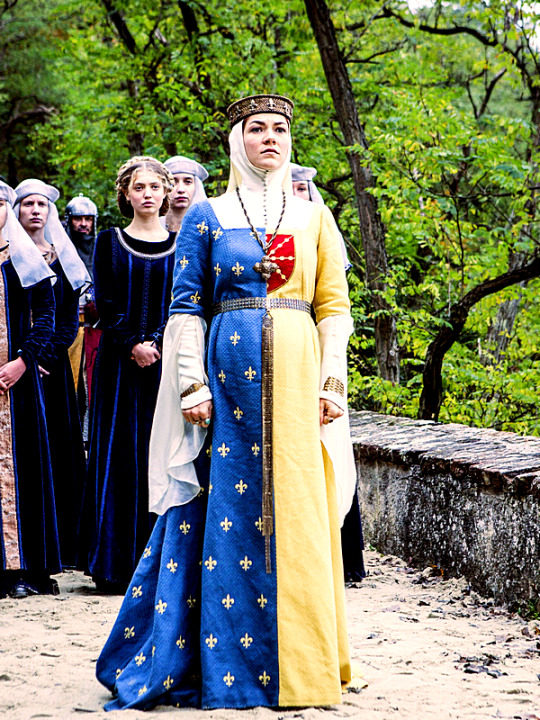
39 notes
·
View notes
Photo
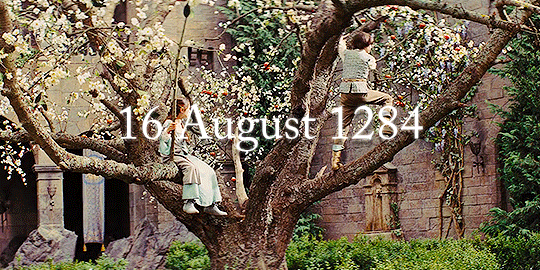


Jeanne I, Queen of Navarre, married the future Philippe IV on 16 August 1284. Jeanne had a very good relationship with Philippe, and, having grown up together, the couple evidently had a close relationship, affectionate and devoted to each other for all their lives.
“Suddenly his shoulders appeared to become bowed. It was simply the matter of a date – 1305! It was the year of the death of his wife Jeanne, who had brought Navarre to the kingdom, and to him the only love of his life. He had never wanted any other woman; and since she had died nine years ago he had looked at none other and would never do so.” - Maurice Druon, The Iron King
#historyedit#perioddramaedit#french history#history#13th century#jeanne de navarre#philippe le bel#joan of navarre#philip the fair#my edits#my stuff#this fancast is not permanent it's just that i had these files on hand and decided to go with it#cuz i'm reading strayer's biography on philippe and i'm SAD#please i love them so much#biopic television series on this man WHEN! when i say!!!
130 notes
·
View notes
Text
Educating the princesses

“All of these princesses, both foreign and French, had received a first-rate education. Some were raised at the French court from childhood, such as Philip IV’s wife Joan of Navarre and Charles VIII’s young fiancée Margaret of Austria. Others were educated within their own families in their respective principalities.
Educators had long debated what women should be taught. In 1265,
Philip of Novara had advised against teaching girls—except for nuns— how to read and write. He was, however, in the minority. Far from being neglected when it came to aristocratic education, women were the recipients of veritable miroirs aux princesses (didactic works presenting the exemplary image of the good ruler or, for women, the ideal princess), which reveal all the care that went into their training—as religious as it was moral and intellectual.
(...)
Beyond these theoretical treatises, sources on the practice of that time provide information about the educational methods of the period. Young princesses learned to read and often write. Such instruction often took place within the palace under a tutor. At the court of Savoy in the mid-fifteenth century, Pierre Aronchel was the schoolmaster of Louis and Anne of Cypress’s eldest daughters Margaret and Charlotte (future wife of Louis XI).
Like their brothers, young princesses first learned reading and religion. They learned to read using an alphabet book (Margaret of Austria learned the alphabet using a book handsomely bound in black velvet) and continued with psalters and books of hours. At the age of seven, young Joan of France, who was married to the Count of Montfort, received a richly illuminated book of hours of Notre-Dame from her mother Isabeau of Bavaria. During the fourteenth century, young girls at the court of Savoy practiced reading using liturgical collections, matins and penitential psalms, which were replaced by books of hours in the fifteenth century. Like their brothers, Savoyard princesses also learned to write.
Latin, however, was reserved for boys, which was one of the primary differences when it came to education. Princesses only knew the necessary prayers and formulas for following mass and reading their books of hours. There were a few exceptions nonetheless. Saint Louis’s sister Isabella of France (d. 1270), for example, was reputedly an excellent Latinist.
Failing Latin, aristocratic ladies knew other languages. John II’s future wife Bonne of Luxembourg, who had been raised in Bohemia, spoke Czech, German and French. Yolanda of Bar —daughter of Robert, Duke of Bar, and wife of John I, King of Aragon—could read ‘Limousin’ and Latin in addition to being able to write in French and Catalan. Others had a harder time learning a foreign language. During her entry ceremony in Paris in 1389, Isabeau of Bavaria was criticized for her poor understanding of French—four years after she had arrived in the kingdom.”
Queenship in medieval france 1300-1500, Murielle Gaude-Ferragu
#history#women in history#women's history#queens#middle ages#medieval women#france#french history#medieval history#isabeau of bavaria#Joan of navarre
99 notes
·
View notes
Text
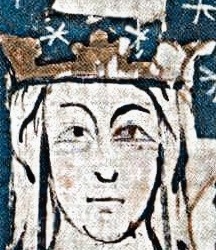

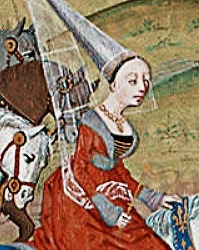


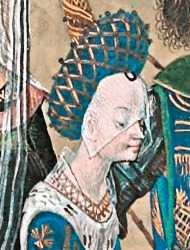


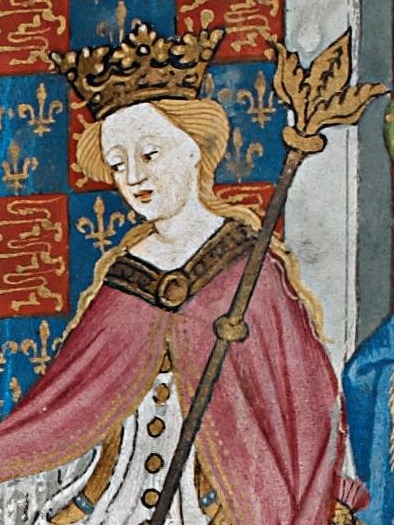

CONSORTS OF ENGLAND SINCE THE NORMAN INVASION (2/5) ♚
Eleanor of Castile (November 1272 - November 1290)
Margaret of France (September 1299 - July 1307)
Isabella of France (May 1308 - January 1327)
Philippa of Hainault (January 1328 - August 1369)
Anne of Bohemia (January 1382 - June 1394)
Isabella of Valois (October 1396 - September 1399)
Joan of Navarre (February 1403 - March 1413)
Catherine of Valois (June 1420 - August 1422)
Margaret of Anjou (May 1445 - May 1471)
Elizabeth Woodville (May 1464 - April 1483)
#my photoset.#history#historyedit#history edit#plantagenets#lancaster#house of lancaster#house of york#elizabeth woodville#margaret of anjou#catherine of valois#the king netflix#the white queen#joan of navarre#isabella of valois#anne of bohemia#philippa of hainault#isabella of france#margaret of france#eleanor of castile#royalty#royals#medieval history#medieval queens#queen consorts#war of roses#english history#historical royals#consorts of england#consorts of england and britiain.
139 notes
·
View notes
Text

#house of lancaster#house of Navarre#house of Brittany#Joan of Navarre#Queen Joan#Joanna of Navarre#Queen Joanna#Jehanne d’Évreux#Plantagenet dynasty#Valois dynasty#house of valois#maison des valois#Henry IV#John V#Lancastrian edit#Lancastrian consort#queen of England#medieval England#naomi watts#Jodi comer
13 notes
·
View notes
Text
Another gift which symbolised [Joan of Navarre's] welcome to the family were two golden tablets worth £79, which were given to Joan on behalf of her new stepsons John of Bedford and Humphrey of Gloucester. Tablets were a type of religious jewellery, which sometimes contained relics or depicted religious scenes and could be worn as a pendant on a chain. It appears that they were extremely fashionable in this period; indeed Ronald Lightbown claims that “by the 1390s the tablet was already a favourite type of devotional pendant in England”. Joan also gave Henry VI a tablet in her later years which was bejewelled with sapphires and emeralds and had an intricate and interesting design. The design featured “an ymage of Seynt George hauyng a crosse upon hys armure” and 12 enamelled lions—given that St George was the patron saint of England and the king's heraldry featured lions rampant, it was a very fitting present for its king. Henry VI also gave Joan a tablet as a New Year's gift in 1436 with a “great sapphire” on it, which had originally been given to him by “my Lady of Gloucestre”, mostly likely Eleanor Cobham—again indicating the cyclical nature of gift exchange by passing on a gift from one member of the royal family to another.
Elena Woodacre, Joan of Navarre Infanta, Duchess, Queen, Witch? (Routledge, 2022)
#joan of navarre#john duke of bedford#humphrey duke of gloucester#henry vi#eleanor cobham#historian: elena woodacre
3 notes
·
View notes
Text
A VISIT TO KING'S LANGLEY
King’s Langley was once home to a massive Plantagenet palace, built out of the remnants of a hunting lodge of Henry III for Edward I’s Queen, Eleanor of Castile. She furnished it lavishly, with carpets and baths. There were shields decorating the hall and a painted picture of four knights going to a tournament, while the expansive gardens were planted with vines. After her death, the palace was…
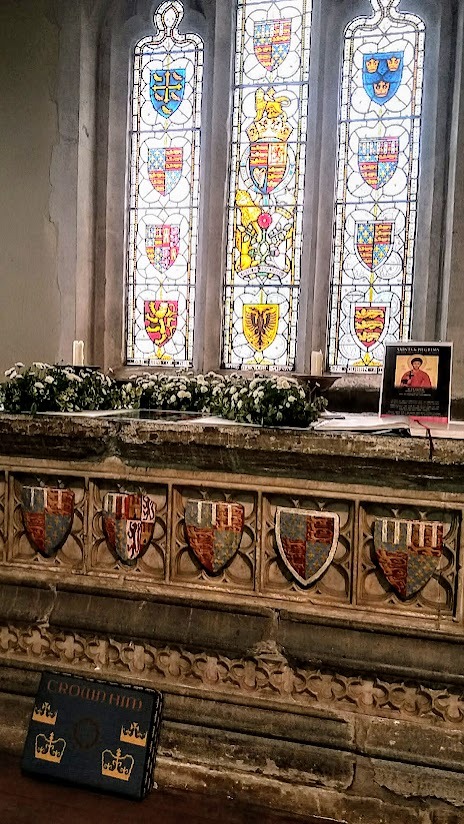
View On WordPress
#Anne Mortimer#camels#Cecily Neville#Christmas#Clarendon Palace#clocks#Dominican friaries#Edmund of Langley#Edward II#Edward III#Eleanor of Castile#fire#Henry III#Henry IV#Isabel of Castile#Joan of Navarre#John of Wheathampstead#King&039;s Langley#palaces#Piers Gaveston#Reformation#Richard Earl of Cambridge#Richard II#royal tombs
10 notes
·
View notes
Note
Hi! I’m reading “Later Plantagenet and Wars of the Roses Consorts” after seeing several interesting posts on it, and I’m a little confused because in Joan of Navarre’s section, Elena Woodacre said that Joan “was certainly the only English queen to have been supposedly accused of witchcraft, even if other royal women were rumored to have dabbled in dark arts”. I may have misunderstood, but didn’t Richard III accuse Elizabeth Woodville of the same in formal Parliament? I think his (Richard’s) accusation was far more explicit, actually: Henry V’s Parliament Rolls say “Joan, queen of England, had plotted and schemed for the death and destruction of our said lord the king in the most evil and terrible manner imaginable”. It’s evident that they probably mean witchcraft, but it’s the Chronicles of London that specify what she was accused of; Henry’s Parliament does not. In Richard’s “Titulus Regius”, however, it’s explicitly stated that “by Sorcery and Witchcraft, committed by the said Elizabeth, and her Mother, Jacquetta" (doubly striking because Jacquetta had already stood trial and been cleared of those charges, with her innocence recorded in Parliament). I think it was probably just a confusing wording choice; I think Woodacre probably meant that Joan was the only queen to be *detained* on the basis of witchcraft (which she mentions in another chapter), although the book also mentions that Joan was never actually formally tried or charged for witchcraft or any other crime (the way Eleanor Cobham and Jacquetta were) so I'm a little confused whether the causes for her detainment were formal or informal or even specified. I don't know much about Joan, though, so maybe I've gotten a few things mixed up.
Hello! Yeah, honestly I don't see how you can say Elizabeth Woodville wasn't actually accused of witchcraft. The allegation against her in parliament doesn't go in full detail but none of the allegations in Titulus Regius do, including the allegation of bigamy, which according to all logic should be really detailed and discussed at length yet it's not. There's also a letter by Richard to his adherents in the North dated 10 June 1483 accusing Elizabeth and her kin to plan his and Buckingham's murder by casting their horoscope, which was something that Eleanor Cobham was also accused of, if I'm not mistaken. I'm calling my friend @une-sanz-pluis here to see if she has any clue about what they mean about Joan's uniqueness in witchcraft allegations.
#sorry i also don't know much about joan of navarre!#ask#anon#elizabeth woodville#joan of navarre#eleanor cobham duchess of gloucester#jacquetta woodville
12 notes
·
View notes
Note
Hi! I'm not not as familiar with 14th/15th century English history as I am with earlier and later periods, and I'm getting conflicting information online, so I wanted to ask: Where Philippa of Hainault and Joan of Navarre formally regents during Edward III and Henry V's reigns? I know Isabella of France technically wasn't, but I'm a little confused regarding Philippa and Joan since different sites are telling me different things, and the book "Later Plantagenet consorts" that I recently read doesn't specify anything.
I wasn't sure whether to send this ask to this blog or your Lancaster side blog so I'm really really sorry if it's inconvenient
Thank you!
No worries, I'll take asks on either of my blogs. 💖 And I'm sorry it took me awhile to answer this; I was trying to finish off the ask about Jacqueline of Hainault and wanted to check some references because I'm not very familiar with Philippa's life. It's actually a very simple answer: neither Philippa or Joan were officially regents for their husband and stepson respectively.
I'm not sure where the story of Philippa's regency comes from; possibly from Froissart who wrote about her leading the English army at the Battle of Neville's Cross but in 1346, England was nominally led by Lionel of Antwerp (who was seven years old) and Philippa had joined Edward III in Calais the month before the Battle of Neville's Cross. It does seem like she had a great deal of authority when Edward was away but lacked the formal position of regent. From Lisa Benz St. John's Three Medieval Queens:
There were never any queen regents or keepers in England, as there were in France. However, fourteenth-century English queens acted in administrative capacities when the king was absent from the realm. Isabella [of France] and Philippa were never officially made regents or custos [keepers], but they played a significant part in ruling the kingdom as one of the king’s central administrators. They administered the kingdom in several ways: they aided the king and chancellor in the chancery; and they acted as part of the institution supporting the regent, who was often one of their sons.
Likewise, Joan of Navarre did not serve as regent during Henry V's absence. From Elena Woodacre's Joan of Navarre: Infanta, Duchess, Queen, Witch?:
In June, before Henry's departure, he formally bid Joan farewell and gave her leave to stay in several royal residences during his absence. He did not, however, entrust her with the governance of the realm—while later sixteenth-century chronicles claim this was the case, it is clear that Henry named his brother John, duke of Bedford, as lieutenant in the king's absence.
5 notes
·
View notes
Text
It's the winter of 1420 and Joan of Navarre, Queen of England has been imprisoned by her stepson King Henry V. A rich widow and an influential political figure, Joan has been accused of witchcraft and plotting to kill the king and now awaits her fate imprisoned in the keep of Pevensey Castle.
#british royal family#joan of navarre#king henry v#womanhood#witch trials#witchcraft#spotify#saga.txt
2 notes
·
View notes
Text
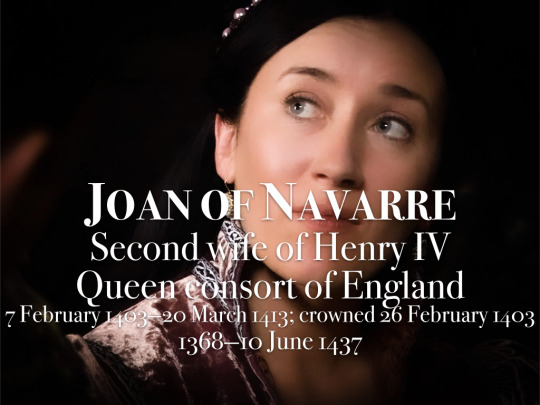
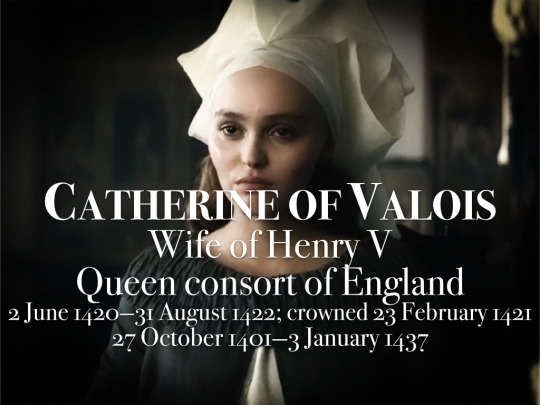

Consorts of England and Britain
House of Lancaster
10 notes
·
View notes
Text
I've been thinking about the tragedy of Elizabeth Woodville living to see the death of her family name.
I don't mean her family with her husband, which lived on through her daughter and grandson. I mean her own.
Her sisters died, one by one, many of them after 1485. When Elizabeth died, only Katherine was left, and she would die before the turn of the century as well.
All her brothers died, too. Lewis died in childhood. John was executed. Anthony was murdered. Lionel died suddenly in the peak of Richard's reign, unable to see his niece become queen. Edward perished at war. Richard died in grieving peace. For all the violence and judgement the family endured, it was "an accident of biology" that ended their line: none of the brothers left heirs, and the Woodville name was extinguished. We know the family was aware of this. We know they mourned it, too:
“Buy a bell to be a tenor at Grafton to the bells now there, for a remembrance of the last of my blood.”
Elizabeth lived through the deposition and death of her young sons, and lived to see the end of her own family name. It must have been such a haunting loss, on both sides.
#(the quote is by Richard Woodville in his deathbed will; he was the last of the Woodville brothers to die)#elizabeth woodville#woodvilles#my post#to be clear I am not arguing that the death of an English gentry family name is some kind of giant tragedy (it absolutely the fuck is not)#I'm trying to put it into perspective with regards to what Elizabeth may have felt because we know her family DID feel this way#writing this kinda reminded me of how I am just not fond at all about the way Elizabeth's experiences in 1483-85 are written about#and the way lots so many of the unprecedentedly horrifying aspects are overlooked or treated so casually:#the seizure and murder of two MINOR sons and the illegal execution of another;#her sheer vulnerability in every way compared to all her queenly predecessors; how she was harassed by 'dire threats' for months;#how she had 5 very young daughters with her to look after at the time (Bridget and Katherine were literally 3 and 4 years old);#how unprecedented Richard's treatment of her was: EW was the first queen of england to be officially declared an adulteress;#and the first and ONLY queen to be officially accused of witchcraft#(Joan of Navarre was accused of her treason; she was never explicitly accused of witchcraft on an official level like EW was)#the first crowned queen of england to have her marriage annulled; and the first queen to have her children officially bastardized#what former queens endured through rumors* were turned into horrifying realities for her.#(I'm not trying to downplay the nightmare of that but this was fundamentally on a different level altogether)#nor did Elizabeth get a trial or appeal to the church. like I cannot emphasize this enough: this was not normal for queens#and not normal for depositions. ultimately what Richard did *was* unprecedented#and of course let's not forget that Elizabeth had literally just been unexpectedly widowed like 20 days before everything happened#I really don't feel like any of this is emphasized as much as it should be?#apart from the horrifying death of her sons - but most modern books never call it murder they just write that they 'disappeared'#and emphasize that ACTUALLY we don't know what happened to them (this includes Arlene Okerlund)#rather than allowing her to have that grief (at the very least)#more time is spent dealing with accusations that she was a heartless bitch or inconsistent intriguer for making a deal with Richard instead#it also feels like a waste because there's a lot that can be analyzed about queenship and R3's usurpation if this is ever explored properly#anyway - it's kinda sad that even after Henry won and her daughter became queen EW didn't really get a break#her family kept dying one by one and the Woodville name was extinguished. and she lived to see it#it's kinda heartbreaking - it was such a dramatic rise and such a slow haunting fall#makes for a great story tho
47 notes
·
View notes
Text



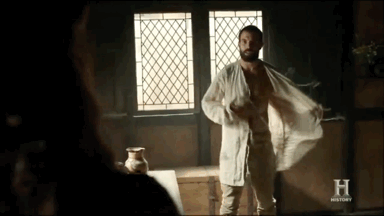
#please enjoy#his cute little lover faces though#if you play it backwards he gets dressed#check out his cute little monk shirt 🤤#love me a warrior monk#monks with abs#knightfall#knightfall s1 episode 1#perioddramaedit#queen joan#queen joan of navarre#tom cullen#period drama
37 notes
·
View notes
Text
Queen Isabella: The She-Wolf of France
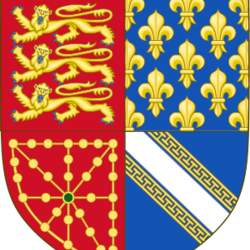

Isabella's coat of arms shows four quarters: the first of her husband, Edward II of England, the second of her father, Philip IV of France, the third and fourth of her mother, Joan I of Navarre, Countess of Champagne.
Image of Isabella, click to enlarge.
Isabella was born the sixth child of King Philip IV of France and Queen Joan I of Navarre. She was the third daughter born, but their only surviving daughter eventually (Margaret had died in childhood in 1300 and Blanche had died after 13th April, 1294). Although Isabella's date of birth is uncertain, both the French chronicler Guillaume de Nangis and the English chronicler Thomas Walshingam describe her as 12 years old at the time of her marriage in January 1308, making it seem that her likely birthdate was between January 1295 and 1296. During her lifetime, she would see three of her brothers, Louis, Philip, and Charles become kings of France.
Isabella was given a good education, taught to read and write, and eventually developed a love of books. She, much like the rest of her siblings, was promised in marriage at a young age. Her father secured a match with Prince Edward, the future King Edward II of England, son of King Edward I of England. The marriage was made with the intentions to resolve the conflicts between England and France over possession and claims of land such as Gascony, Normandy, Anjou and Aquitaine. Pope Boniface VIII had urged for the wedding to go ahead as early as 1298, meaning Isabella would be around only 3 years old while Edward would have been around 14 years old. Edward I of England attempted to break the engagement several times, and it only went ahead when Edward I died in 1307.
Edward, now King Edward II of England, married Isabella of France on the 25th of January, 1308 at Boulogne-sur-Mer in France. Isabella was probably around 12 years old at the time of her marriage. She was now the Queen consort of England. Edward was 23 years old. During the wedding feast, Edward chose to sit with Piers Gaveston, a favourite of his, rather than Isabella. She soon complained to her father that she received insufficent funds and that Edward visited Galveston's bed more than her own. Eventually, Edward was force to exile Gaveston to Ireland for a period of time to show respect to Isabella.
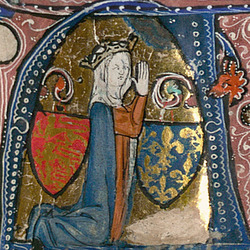
Isabella depicted as queen.
Edward had male favourites at court: Piers Gaveston and Hugh Despenser the Younger. When Edward became king, he had inherited a country at war with Scotland, and with his own barons, in particular his first cousin, Thomas, the 2nd Earl of Lancaster, who was a grandson of Henry III of England, and who's uncle had been Edward I of England. Isabella found her way through these challenges, forming a successful alliance with Gaveston, until his death at the hands of the barons. Isabella found herself at increasing odds with her husband when Edward allied himself with the Despenser family, particular Hugh the Younger.
Between the years of 1312 and 1321, Isabella gave birth to four children and is said to have suffered at least one miscarriage. A son, Edward, the future Edward III, was born in 1312; another son, John, Earl of Cornwall, was born in 1316; a daughter, Eleanor of Woodstock, was born in 1318; and another daughter, Joan of the Tower, was born in 1312. Her daughter Joan went on to marry King David II of Scotland in accordance with the Treaty of Edinburgh-Northampton.
There even appears to have been an attempt to capture Isabella at one point in 1319. The Scottish general, Sir James Douglas, who was a war leader for Robert I of Scotland, personally tried to capture Isabella at York and almost succeeded, however Isabella just barely escaped. It was unproven though suspicions fell of Thomas, Earl of Lancaster, and a knight of Edward's, Edmund Darel. It was during this time that Edward had begun a sexual relationship with Hugh the Younger, and had begun making enemies in the form of the Mortimer's. With Lancaster moving against them, Isabella pleaded with Edward on her knees to send the Despensers into exile, which he did and vowed to bring them back at the first opportunity available to him.
By January 1322, Edward's army was reinforced with the Despensers returning from exile. They had forced surrender from the Mortimers and by March 1322, Lancaster had been captured after the Battle of Boroughbridge and executed. Another campaign for Scotland resulted in failure when Isabella was cut off from the South, refused help from the Despenser forces, and her husband had retreated south and had left her and her household. Eventually, Isabella made it to York but she was furious with both Edward and the Despensers.
Isabella had efectively separated from Edward from here onwards and by the end of 1322 had left for a 10 month long pilgramage around England by herself. By 1324, tensions between England and France had grown, and Edward and the Despensers had confiscated all of Isabella's lands, began running Isabella's household, arrested and imprisoned her French staff, and had taken away her children from her, putting them in the custody of the Despensers.
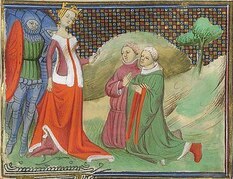
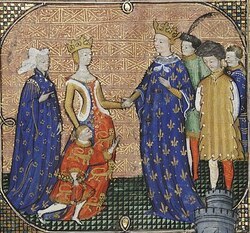
Hugh Despenser the Younger and Edmund Fitzalan brought before Isabella for trial in 1326 before they were executed.
Future Edward III as a boy showing homage to his uncle, Charles IV of France centre right, with his mother, Isabella, in September 1325.
When Charles IV of France, Isabella's brother, seized Edward II's French possesions in 1325, Isabella returned to France. Initially, she was to be a delegate to negotiate a peace treaty between the two nations, however Isabella gathered an army to oppose Edward, in alliance with Roger Mortimer, the 1st Earl of March, with whom she had entered into a relationship. When they returned to England with their army, they quickly took the country, forcing Edward's abdication and executing the Despensers. Edward was held in the custody of Henry of Lancaster, the brother of the late Thomas, Earl of Lancaster.
Isabella had her son, Edward, confirmed as Edward III of England with herself being appointed as regent in January of 1327. On the 23rd of September of the same year, Isabella and Edward III were informed of Edward's death while imprisoned in Berkeley Castle on the Welsh borders. Though described as a "fatal accident", there was a rumour that Isabella and Roger Mortimer had had Edward murdered, and another rumour that said he was alive somewhere in Europe.
During her regency, Isabella had her son, Edward, married to Philippa of Hainault in 1328, something she had agreed to before the invasion of England had taken place. She had her daughter, Joan, married to David, the son of Robert the Bruce, in 1328 also. She also had Edward III renounce any claims on Scottish lands in exchange for the promise of Scottish military aid against any enemy, except the French, and £20,000 in compensation for the raids across northern England. Isabella tried to claim the French throne on behalf of her son, demanding France to recognise her sons claim. When that failed, she decided to court France's neighbours by proposing marriage between her son, John, into the Castilian royal family.
Isabella practically ruled England for her child as regent along with Mortimer for four years, until Edward III deposed Mortimer in a coup and taking the authority for himself in mid-1330. Mortimer was executed at Tyburn on the 29th of November, 1330, aged 43 years.
In Isabella's final years, she became close to her daughter, Joan, doted on her grandchildren, including Edward, the Black Prince, and became interested in religion. She took the nun's habit of the Poor Clares before she died on the 22nd of August in 1358 at Hertford Castle. Her body was returned to London and buried at the Franciscan church at Newgate. At her request, she was buried in the mantle she had worn at her wedding. Her husband's heart was interred with her. She left the bulk of her property to Edward, the Black Prince, reported to be her favourite grandchild, and some person effects to her daughter, Joan.
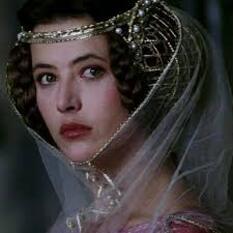

Over the years, she has been portrayed in both theatre and film, most notably by Tilda Swinton in Edward II (1991) and by French actress Sophie Marceau in Braveheart (1995).
(Information cited from Wikipedia, History of Royal Women, Britannica, World of History, and History Extra)
#isabella of france#she-wolf#france#england#edward ii#edward iii#rogert mortimer#thomas lancaster#hugh despenser the younger#despensers#scotland#philippa of hainault#piers gaveston#philip iv of france#joan i of navarre#edward ii of england#edward iii of england#queen of england#queen consort#history#royal history#history with joanna
5 notes
·
View notes
Note
Can you do Queen Joan, Princess Isabella and Queen Margaret’s clothes from Knightfall (2017-2019)?
I never watched past the first episode bc it was too male-coded for my personal taste but I think I already have a request for Isabella anyway. I will see what I can do.
4 notes
·
View notes